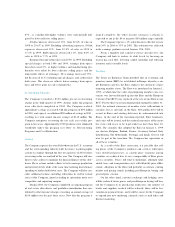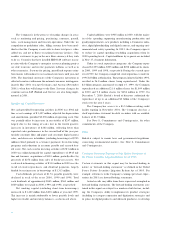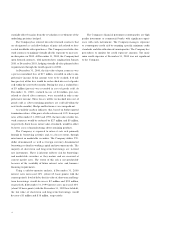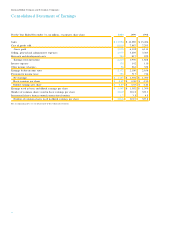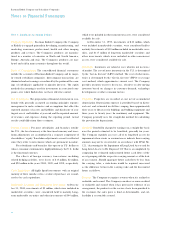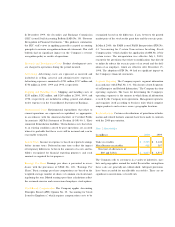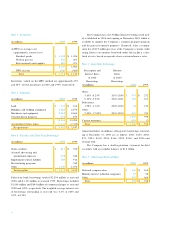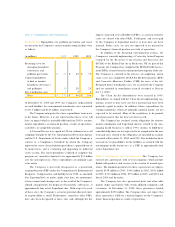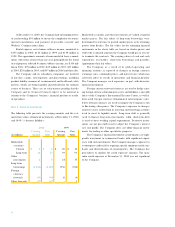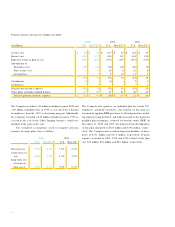Kodak 2000 Annual Report Download - page 47
Download and view the complete annual report
Please find page 47 of the 2000 Kodak annual report below. You can navigate through the pages in the report by either clicking on the pages listed below, or by using the keyword search tool below to find specific information within the annual report.Note 1: Significant Accounting Policies
Company Operations Eastman Kodak Company (the Company
or Kodak) is engaged primarily in developing, manufacturing, and
marketing consumer, professional, health and other imaging
p roducts and services. The Company’s products are manufac-
t u red in a number of countries in North and S outh America,
E u rope, Australia and Asia. The Company’s products are mar-
keted and sold in many countries throughout the world.
Basis of C onsolidation The consolidated financial statements
include the accounts of Eastman Kodak Company and its major-
ity owned subsidiary companies. Intercompany transactions are
eliminated and net earnings are reduced by the portion of the earn-
ings of subsidiaries applicable to minority interests. The equity
method of accounting is used for investments in associated com-
panies over which Kodak does not have effective contro l .
Use of Estimates The preparation of financial statements in con-
f o rmity with generally accepted accounting principles re q u i re s
management to make estimates and assumptions that affect the
re p o rted amounts of as sets and liabilities and disclosure of con-
tingent assets and liabilities at year end and the re p o rted amounts
of revenues and expenses during the re p o rting period. Actual
results could differ from those estimates.
F o reign Curre n c y For most subsidiaries and branches outside
the U.S., the local currency is the functional currency and trans-
lation adjustments are accumulated in a separate component of
s h a reholders’ equity. Translation adjustments are not tax-eff e c t e d
since they relate to inves tments which are permanent in nature .
For subsidiaries and branches that operate in U.S. dollars or
whose economic environment is highly inflationary, the U.S. dollar
is the functional curre n c y.
The effects of foreign currency transactions, including
related hedging activities, were losses of $13 million, $2 million,
and $20 million in the years 2000, 1999, and 1998, re s p e c t i v e l y.
Cash Equivalents All highly liquid investments with an original
maturity of three months or less at date of purchase are consid-
e red to be cash equivalents.
Marketable Securities and Noncurrent Investments At Decem-
ber 31, 2000, investments of $5 million, which were included in
marketable securities, were considered held to maturity. Long-
t e rm marketable securities and other investments of $44 million,
which were included in other noncurrent assets, were considere d
available for sale.
At December 31, 1999, investments of $10 million, which
w e re included in marketable securities, were considered held to
m a t u r i t y. Investments of $10 million included in marketable secu-
rities, and $117 million of long-term marketable securities and
other inves tments which were included in other noncurre n t
assets, were considered available for sale.
I n v e n t o r i e s Inventories are valued at cost, which is not in excess
of market. The cost of most inventories in the U.S . is determ i n e d
by the “last-in, first-out” (LIFO) method. The cost of other inven-
tories is determined by the “first-in, first-out” (FIFO) or average
cost method, which approximates current cost. The Company
p rovides inventory re s e rves for excess, obsolete or slow-moving
i n v e n t o ry based on changes in customer demand, technology
developments or other economic factors.
P ro p e rt i e s P ro p e rties are re c o rded at cost net of accumulated
d e p reciation. Depreciation expense is provided based on histor-
ical cost and estimated useful lives ranging from appro x i m a t e l y
t h ree years to fifty years for buildings and building equipment and
t h ree years to twenty years for machinery and equipment. The
Company generally uses the straight-line method for calculating
the provision for depre c i a t i o n .
G o o d w i l l Goodwill is charged to earnings on a straight-line basis
over the period estimated to be benefited, generally ten years.
The Company regularly assesses all of its long-lived assets for
i m p a i rment when events or circumstances indicate their carry i n g
amounts may not be recoverable, in accordance with SFAS No.
121, “Accounting for the Impairment of Long-Lived Assets and for
Long-Lived As sets to Be Disposed Of.” This is accomplished by
comparing the estimated undiscounted future cash flows of the
asset grouping with the respective carrying amount as of the date
of assessment. Should aggregate future cash flows be less than
the carrying value, a write-down would be re q u i red, measured
as the diff e rence between the carrying value and the discounted
f u t u re cash flows.
R e v e n u e The Company recognizes revenue when it is realized or
realizable and earned. The Company considers revenue re a l i z e d
or realizable and earned when it has persuasive evidence of an
a rrangement, the products or the services have been provided to
the customer, the sales price is fixed or determinable, and col-
lectibility is reasonably assure d .
46
Eastman Kodak Company and Subsidiary Companies
Notes to Financial Statements



